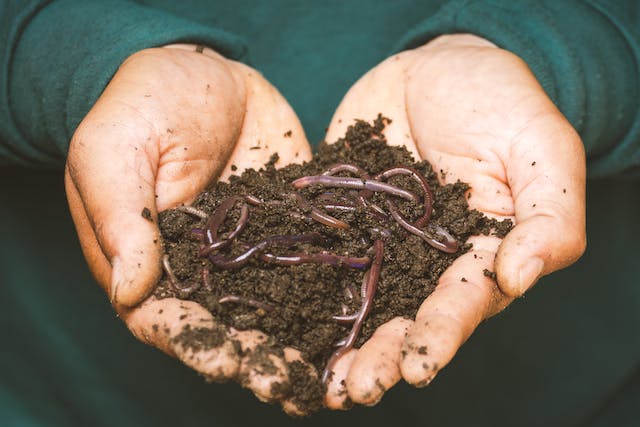
What do worms do? They break down organic matter in the soil and release the nutrients in their waste.
Earthworms may all look the same to us, but there are 7,000 different species of them across the world. 150 of those species are the ones we commonly see. There are far more worms in the soil underneath us than we know. 1 square meter of soil can have between 250 and 1,000 earthworms in it.
What are the worms doing in that soil? They do four things that make them a vital part of the ecosystem. The first is that they recycle the organic matter that has fallen onto the ground. Leaves, dead plants, dead animals, and anything that has fallen on the ground and can be biodegraded. Worms don’t have teeth. They have a mouth at one end and they can create enough suction to pull food in through it. Worms have a gizzard, similar to chickens, where they use mineral particles to grind up the food they have eaten. Chickens eat stones to serve the same purpose. Once the food is ground up, it continues along their intestine, where they break down the proteins, the cellulose, the fats, and other plant materials. The intestine is straight and it has muscles to move food along it. Once they have taken out what they need, it carries along their intestine and they excrete what is left. This worm poo is excellent food for plants and makes the soil very fertile. Worm poo contains 5 times more nitrogen, 7 times more phosphorous, and 1,000 times more good bacteria than soil that worms don’t live in. All of this makes the soil more fertile and makes plants and crops thrive.
The second thing they do is aerate the soil. Healthy soil must be aerated. Worms move through soil by burrowing. They have muscles along their bodies that they can contract. They anchor the front part of their bodies with short hairs called setae then contract their bodies, pulling themselves forwards. Then they extend their front half, anchor with the hairs and repeat the process. As they burrow through the soil, they eat the soil as they go. The tunnels that they make allow oxygen to flow through the soil. They also loosen the soil. If soil is too compact, it is difficult for plant roots to grow through it and if there is not enough oxygen, the plant’s root systems can’t work properly.
The third thing they do is repair damaged soil. Soils can be damaged in many different ways. They can be polluted by waste from factories, by run off from farms, and in a host of other ways. Worms can fix these polluted fields. Worms can eat a lot of pollutants and they have enzymes that detoxify them. Worms also make the soil healthier by increasing the number of microbes that can live there. These microbes are also able to break down many of the pollutants. They can’t break down all pollutants, but they can do a lot to help repair damaged soils.
The fourth thing they can do is be eaten. Worms are a food source for a lot of different animals. They are rich in proteins and are a good meal for birds, hedgehogs, and many other animals.
Why do worms come out of the ground when it rains? You may have noticed that there are far more worms out of the soil just after it has rained. What is the reason for this? It turns out that no one actually knows the reason. There are several theories. Here are three of them. They come to the surface to avoid drowning. Worms don’t have lungs. They take in oxygen trough their skin. When it rains, the ground becomes water-logged and there is less oxygen for the worms. They could surface to find more oxygen. It could be because they can move much faster on the surface. Worms eat the soil as they travel and that takes a long time. They can tunnel about 10 meters in one hour. They can travel much faster on the surface. When it rains, the soil is easier to move through and they can come out of the ground without drying up. The last reason is because they mistake the sound of the rain hitting the soil as a predator and they run away from it. Nobody knows the real reason. Maybe we will find out one day. And this is what I learned today.
Photo by Sippakorn Yamkasikorn: https://www.pexels.com/photo/earthworms-on-a-persons-hand-3696170/
Sources
https://www.wigglywigglers.co.uk/blogs/blog/how-many-worms-do-i-have-in-my-garden
https://web.extension.illinois.edu/worms/live/
https://en.wikipedia.org/wiki/Earthworm
https://www.gardeningknowhow.com/garden-how-to/soil-fertilizers/why-does-soil-need-aerating.htm
https://www.frontiersin.org/articles/10.3389/fenvs.2022.924480/full
https://www.eekwi.org/animals/other-invertebrates/earthworm-castles
https://spectrumnews1.com/ky/louisville/weather/2021/05/06/the-dirty-truth-about-worms-and-rain
